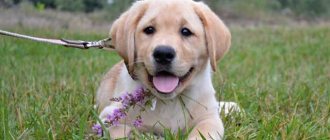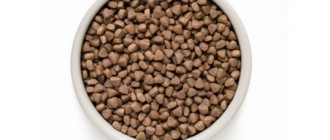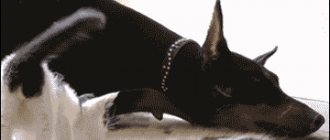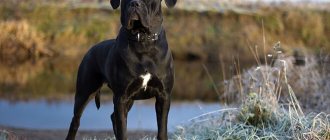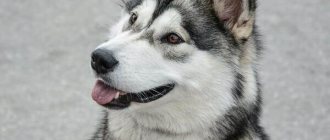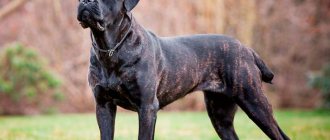Labrador Retriever is the most popular dog breed all over the world. The dog has a lot of innate talents and is predisposed to quickly acquiring the skills and abilities necessary for the owner. If you are looking for a beautiful dog with a powerful and strong build, with a soft and easy-going character, which can become your faithful assistant in hunting, fishing and family, then this breed is ideal for you.
Breed Features
The Labrador is a dog-friend, a companion dog. The breed is universal, because these dogs can be used as guide dogs, hunting assistants, and even nannies. It is surprising that the characteristics of these dogs are so diverse and include so many canine “professions”.
Labradors are very friendly and obedient dogs with a stable psyche. They respond well to training.
Ideal for living in a large family with children. They have a great time in the company of people and love everyone indiscriminately. So, perhaps, the only negative that can be found in the description of the breed is their inability to distinguish enemy from friend. Labradors are not suitable as a watchman, unless they lick a creeping robber to death.
These dogs love to swim. Nature has rewarded them with a special paw structure. They have membranes, which allows the dogs to move in the water faster than a duck and not get tired for a long time while swimming. Their tail is similar to that of an otter. Labradors spin it in the water and thereby change the direction of movement. Dogs' fur is also adapted to water procedures - it is thick and multi-layered, and the bottom layer is covered with fat.
The back of the Labrador's body has a reinforced muscle corset, which allows them to jump high and far. The recorded jump record for a Labrador is 8 meters in length. However, this advantage is overshadowed by possible joint problems as the dog ages.
When carrying something in their mouth, Labradors do not damage it by clenching their teeth. This canine feature is called a “soft mouth.” This is very important for future owners with small children. Labradors are quite healthy and are not afraid of the cold. They have an excellent memory, are quickly trained and try to take a leading position in the owner’s family.
History of the Labrador Retriever breed
Labrador is a gift from the New World to old Europe, but the country of origin of the breed is officially considered to be Great Britain. It was there that in the 19th century the ancestors of modern dogs were brought, which were then crossed with English breeds. Find out about other dogs bred in the UK - the Greyhound and the Miniature Bull Terrier
And the background was like this. For the first time, animals called “St. John’s water dogs” were mentioned in documents from 1593, which described the voyage of the ship Marigold. It says that on the Canadian island of Newfoundland there are unusual dogs that are black in color and smaller in size than greyhounds. But most importantly, these dogs are very loyal, they do not leave their fishermen’s owners a single step. They even go fishing with them.
How these “little Newfoundlands” got to the island is not exactly established. There is an assumption that they were brought by Portuguese sailors. In their homeland, water dogs (can-diagua) were popular and helped sailors. They could retrieve things that had fallen overboard and save people, delivered messages from ship to shore, and even caught fish in nets.
In the 19th century, the ancestors of Labradors were transported from Canada to the United Kingdom on merchant ships. The British immediately appreciated the working qualities of the new dogs. They realized that “little Newfoundlands” were excellent for hunting and could easily handle retrieving waterfowl. To improve the breed, the imported dogs were crossed with foxhounds, retrievers and setters. The modern name “Labrador” was adopted at the end of the 19th century, around 1870.
The first breeders of the breed were the Earl of Malmesbury and the Duke of Buccleuch. They became the founders of nurseries and acted independently. This is probably why Labradors have several varieties. The confusion in the breed has reached the point of absurdity. Sometimes puppies from the same litter were assigned to different “branches” based on their appearance.
There are three versions explaining the origin of the name “Labrador”. According to one of them, dogs began to be named after the mountain mineral Labradorite. According to another, the breed was named after the Canadian Labrador Peninsula, so as not to confuse it with Newfoundlands. According to the third version, the name comes from the Portuguese word “trabalhador”, which means worker. Allegedly, this is what the dogs were nicknamed for their high performance.
In 1903, the English Kennel Club officially recognized the breed and adopted the first standard. In 1916, the Labrador Retriever Club was created in Great Britain (a club for lovers of Labrador retrievers), which cares about the purity of the breed to this day.
During World War I, Labradors crossed the ocean again and reconquered America. However, their own type of breed was formed there and a special American standard was adopted. According to him, the dog can be taller.
Labradors were brought to the Soviet Union at the end of the 1960s. It was a very rare breed back then. And in modern Russia there are dozens of kennels where you can buy these dogs.
Conditions for keeping
Many owners of private houses are concerned about the question of where to keep a Labrador. It is unpleasant if the dog freezes in winter or suffers from the heat in summer. In fact, this breed of dog feels good both in the house and on the street, if you provide it with the necessary comfortable conditions.
In a private house or apartment, an active dog can create a serious mess, sweeping away everything in its path with its fluffy and restless tail. Regular mischief can be prevented only by good education and training.
In an enclosed space, the dog must have its own corner, where its bedding and a couple of toys lie. The resting place should be located away from radiators and drafts so that the Labrador is comfortable and warm, but not hot.
For adult dogs, several layers of fabric wrapped in a blanket, a piece of thick carpet or a flat pillow can be used as bedding. If there is a removable cover on the litter, then it will be much more convenient for the owner to keep this place clean. You need to clean up after your dog every day, sweeping away any loose hair. Once a week it is necessary to wipe the floors without using aggressive detergents.
Living in a private yard can be a real pleasure for your dog if you give him space to play and a comfortable place to rest. An equipped enclosure will help the dog behave actively, which means that the Labrador will not get bored. Ideally, the enclosure will be located on a lawn with grass, and no more than half of this place will be illuminated by bright sun in the summer.
It is necessary to leave a bowl of clean water in the enclosure, since a constantly frolicking dog must be able to quench its thirst at any time. It is better to bring food in accordance with the chosen regime.
An equipped kennel will help protect the dog from the sun and rain, and will also warm you up on cold nights. The inside of the booth should have warm upholstery, and the location of the house should be thought out in advance: constant shadow or scorching rays of the sun are not the best option.
Preference for building a booth should be given to natural materials, such as wood. Then the house will not be too hot in summer and not too cold in winter.
And during severe cold weather, it is better to give the Labrador a place to sleep inside the owner’s premises.
Appearance
First of all, let's find out what a Labrador looks like.
Standard
The standard gives the following characteristics of the breed: a representative of this group must have a fairly strong build, a wide chest and strong limbs. The height of males is usually about 55-57 cm, and this figure for females is 54-56 cm. Many owners think about how long Labradors live. The average lifespan of dogs is 12-13 years. The average weight of a Labrador is 25-30 kg.
The animal's head should be wide enough, but not round or thick with large cheeks. The muzzle is usually pointed, the transition from the forehead to the nose is clearly visible. Eye color varies from hazel to dark brown. Dogs have drooping ears, but not too large. It is noteworthy that the ears of these animals act as a kind of transmitter of his emotional disposition and are characterized by increased mobility.
The back of dogs should be straight with a short but strong loin. The tail is usually of medium length, very thick at the very base. The front legs are straight and fairly strong. The hind limbs are very strong and extremely developed. All movements of dogs in this group are distinguished by a fairly free range.
Coat type and colors
The Labrador, the photo of which is provided below, has thick but rather short hair. Equipped with a waterproof undercoat. It feels hard when touched. Remember that the animal's fur should not contain any streaks or frays. Labradors shed quite a lot, so in the spring they need to be combed additionally (or they will comb themselves on any piece of furniture they like in your home). Young Labrador puppies require special hygiene.
There are only three main colors: black, fawn Labrador (from light cream to red) or brown Labrador (better known as chocolate Labrador). Remember that if you are offered to buy a puppy of a “rare” color (meaning white Labrador or silver), then this is simply a scam. A purebred Labrador cannot have such colors. You can learn more about the appearance of dogs by watching our Labrador video.
How to properly care?
Labradors are fairly unpretentious dogs. Special care only needs to be taken for the puppy, since he is susceptible to various diseases and problems. Dogs of this breed are very clean, so caring for them at home is not difficult. Let's take a closer look at how to properly care for your Labrador.
Walking mode
Labradors are very active dogs . They need to splash out their energy somewhere, so walks are an integral part of the healthy lifestyle of these dogs. To meet their needs, you need to walk them at least twice a day for an hour.
A leisurely walk on a leash in the park is not what Labradors need. They should be allowed to play and run without a leash. The best option would be to find a friend for your dog, the same breed or similar in behavior. Then the Labrador will receive the positive emotions and activity it needs.
Education and training
Labradors respond well to training. If you constantly talk to your pet from early puppyhood, show him what is good and what is bad, he will grow up to be a wonderful dog. He will understand ordinary words and even gestures. But for comfortable coexistence, the puppy should be taught basic commands. Of course, you need to start with getting used to the nickname, then the prohibition “no” or “fu” and what will help during the walk - “near” and “to me.” It must be remembered that a playful baby will grow into a fairly large dog. If she doesn't get used to walking on a leash next to you, it will be difficult to restrain her. And she must return at the request of the owner, this is especially important when living in the city.
You need to train your pet by playing with it; activities should bring pleasure to both parties. Small Labradors need to be treated gently, with affection. Reinforce the right actions with something tasty. Of course, it will take a lot of patience to teach your puppy commands. But this is necessary, otherwise an adult dog will cause a lot of trouble. You can exercise in the company of other dogs, this way you will teach your pet social behavior. It is useful to take a general training course under the guidance of a professional. A Labrador who has successfully passed the OCD is an ideal dog for city life. With her, you won’t be ashamed or afraid to go out onto a crowded street.
Beginning lovers of the breed often wonder whether it is worth taking a course in protective guard service with a Labrador. They hope that these activities will turn their pet into a guardian. Experienced dog breeders strongly advise against attempting such an experiment. The Labrador Retriever by nature lacks these protective qualities; it is not aggressive. Therefore, a course of ZKS will negatively affect the dog’s psyche. The dog will not be a good bodyguard, but there may be problems.
The Labrador will gladly support the hobby of its owner-hunter, will be a companion for an athlete, and will play outdoor games with children. He will be grateful for trips to the forest and bike rides, and will also be very happy if he is taken to the beach. These dogs are natural swimmers.
Labrador nutrition
Keeping a Labrador, like any pet, must start with good nutrition. However, let’s make a reservation right away: the animal should not be overfed, since excess weight contributes to the development of diseases in the dog, deterioration of activity and quality of life. As a rule, Labrador Retriever puppies fall into the hands of their owner already adapted to eating independently.
In the first months, the baby is fed 5-6 times a day. With age, feeding is limited to two to three meals, depending on the activity of the animal. Care and feeding are interconnected things, so it is better to prepare a complete diet in advance, which will include high-quality food, home-cooked natural food and special dietary supplements. Labradors are prohibited from eating sausages, cookies, candies, any spices, baked goods, fatty foods and meats, and legumes. In addition, you should not feed your dog between meals.
Pros and cons of the breed
Labrador Retrievers are extremely popular all over the world. This breed is consistently included in the top lists of various ratings. They managed to win a place in the top ten of the smartest, most loyal, kindest and hardworking dogs.
Let's list what qualities make a Labrador a family super dog:
- Positive attitude towards life;
- friendliness;
- obedience;
- activity;
- loves children;
- gets along with pets;
- friendliness towards all people;
- balanced character.
The list of positive qualities goes on. This will include the ability to empathize, excellent instincts, and love of love. But wonderful Labradors also have their drawbacks. Let's list what's wrong:
- Lack of security qualities;
- needs movement and long walks;
- prone to gluttony;
- cannot stand loneliness;
- You will need to teach at least basic commands;
- sheds profusely;
- loves to get into the mud.
Caring for a puppy from the first days
Caring for a Labrador puppy in the first days after its arrival at home should be primarily associated with accustoming the dog to its new place of residence and teaching the basics of discipline. Small Labrador Retrievers are very playful and lively dogs who pay more attention to communication with their family than to hygiene. To ensure that your dog stains as few surfaces as possible, remove carpets and small objects from the floor.
For Labrador puppies living at home, it is often recommended to install an enclosure measuring 2x2 m in the apartment, in which the kids will stay during your absence. Bowls for food and water, as well as a place to sleep, are installed in the Labrador's enclosure. In the first days, the animal gets used to your family, home and yard in which it will take walks. Therefore, it is better to immediately begin introducing the dog to the environment and people, redirecting the dog’s energy not only to games, but also to training.
Choosing a puppy
Where to buy
When you decide to purchase a puppy, decide on the purpose or reason for your purchase. Labrador Retrievers can be purchased for breeding, for participation in competitions or for the hobby. If your family needs a dog as a companion, then you can contact Labrador owners through an advertisement, but then you risk purchasing a dog of a similar breed. You can't be sure that a dog that looks like a Labrador will actually grow up to be one.
As a safety net, you can talk to the owners of real Labradors with documents, if you have them, or with breeders. Knowledgeable people will help you with your choice.
If you need a dog for breeding or to participate in competitions, you only need to contact breeders. By purchasing a dog, you receive absolute guarantees in the form of official documents that confirm that your dog is exactly the breed you need. By contacting the nursery, you will have the opportunity to meet the parents of your future friend, look at their upbringing and behavior. Kennels strictly monitor the dog’s upbringing so that it grows up kind and does not show aggression. The dog is well cared for. After purchase you will receive a puppy card and a veterinary passport. A shelter dog is also distinguished by a small mark on the groin or behind the ear.
Whom to prefer
When determining the gender of the puppy, please note that girls’ behavior is calmer and they are a little friendlier than boys. But girls are more stubborn, and they go into heat twice a year. During this period, males should not be allowed near her if you are not yet ready for puppies.
The boy, when he grows up, will become a large and powerful male. Boys are very active and require a lot of attention. However, dog handlers and owners of Labrador retrievers believe that male dogs are more loyal to their owner and quickly find a common language with other pets.
What to look for when purchasing
The puppy should give the impression of being well-groomed. Ears and eyes must be clean. Ask the breeder or seller to tell you about the puppy's parents. The age of the dog upon purchase must be one and a half months or at least 8 weeks.
At the first meeting, the puppy should not show aggression or bare its teeth. His behavior should not be timid. The baby should be friendly, moderately active and curious. The body of a healthy puppy is dense, without fat deposits. The dog's skin must be free of damage or scratches. The baby should have a healthy appetite.
In addition, please note that the puppy will need a place to sleep, food bowls, food, toys, a leash and a collar for walking.
How to prepare a home and place for a puppy
Before you bring your pet into the house, you need to collect all the carpets in the house, get rid of or hide small objects that could harm the baby, or that the puppy could accidentally swallow. All kinds of wires in the house, be it electrical wires, telephone wires or from the Internet, need to be hidden or secured high. The pills found by the dog can be eaten by him, which will lead to adverse consequences. Shoes will also be attractive to the puppy, so they should also be hidden.
Ear care
Caring for a Labrador Retriever necessarily includes a number of hygiene procedures that will help maintain the health and beauty of your pet. One of these procedures is ear cleaning, and it is better to learn in advance how to properly care for your dog’s auditory receptors. This procedure is carried out once a week using a cloth made of natural fabric, moistened with water at room temperature. Instead of water, ears are often washed with ear canal cleaning lotion. You should not use cotton pads, swabs or puffs - small hygiene items can get directly into the ear canal if the animal moves suddenly.
Ears should be checked for mites, foreign objects, and foul odor. Labradors may reflexively scratch their ears on various surfaces or shake their heads. In both cases, you should immediately contact your veterinarian.
Dental care
An important part of hygienic care and maintenance of a puppy is brushing its teeth, which is carried out every 2-3 months using toothpastes for dogs. This procedure is usually done in a veterinary clinic, but any dog breeder can learn the basics. Monitor your bad breath and the color of your teeth. Darkening or yellowing of the enamel is rarely observed in puppies, but they can indicate nutritional disorders, and a foul odor can be a prerequisite for serious illness. Raw vegetables and bones are an excellent preventative against yellowness and tartar.
Health and illness
The Labrador Retriever breed has health characteristics. Its representatives cannot be called too painful, but they require an annual preventive visit to a veterinary specialist.
Retrievers experience the following diseases:
- Obesity, because Labradors love to eat, and their owners often indulge them. As a result, the pet becomes overweight, which affects the functioning of its heart and musculoskeletal system.
- Hypothyroidism is a decrease in thyroid function. It can only be detected through testing. If the result is negative, then the owners are advised to reconsider the pet’s diet, because overeating causes problems with the thyroid gland.
- Dysplasia of the hip and elbow joints. Many large breeds are susceptible to the disease, not just Labradors. To a greater extent, it is determined by genetic predisposition.
- Panosteitis is an inflammatory process in the internal canal of long bones. The disease is age-related and affects puppies from 6 months to 1.5 years.
- Osteochondrosis is a thickening of cartilage that occurs in puppies from 5 to 18 months. More common in males than females.
- Retinal atrophy and cataracts. Rarely occurs in retrievers, cannot be treated, affects dogs from 4 to 7 years old.
Lifespan
Modern dogs live much less than the established period of 12-14 years. If an animal has passed the 12-year mark, it is considered a long-liver. The average lifespan of the Labrador dog breed is from 8 to 10 years.
Grooming
Grooming a Labrador and inventing hairstyles are not necessary procedures, since the hair of the breed is short. It is enough to comb the dog 2-3 times a week with a special brush and subject the dog to water procedures once every 3 months. Washing a puppy is difficult, but gradually it needs to be accustomed to detergents.
Labradors love baths, but babies may be scared of the foam. Wash your dog under warm running water using a special shampoo for dogs. Do not use soap or human hygiene products, as they can wash away all the fat underneath the fur and dry out the skin.
Color variations
The breed standard specifies the following colors for the Labrador :
- Black with pigmentation of lips, paw pads, nose and eyelids;
- Chocolate (brown) with brown pigmentation;
- Ginger;
- Golden;
- The fawn has a light colored coat with dark pigmentation on the lips, eyelids and nose.
There are also spotted, white and silver Labradors, but this color is a mutation .
Nail care
Now that we've figured out how to wash a Labrador, we should figure out how to care for a Labrador puppy's nails. Nail trimming is done if necessary once every 4–8 weeks using a nail clipper. Press on the dog's paw pads to make the nails appear. Carefully, without touching the skin, trim the nails 3-4 mm above the burgundy part. This procedure is quite difficult to do with your own hands, but regular walks with your dog on concrete surfaces or sandstone will completely relieve you of the need to trim their nails.
Walking a Labrador
Walking a puppy is also part of the full care of a small pet. For a Labrador Retriever, the first walk outside can be very stressful, so getting to know the street lasts no more than 5 minutes. In the following days, walking increases to 20 minutes, and when the dog finally gets used to it, walks can be increased to 2 hours.
A small dog is not yet able to move long distances, overcome obstacles or flights of stairs. Therefore, while keeping a puppy, spend more time playing at home than walking, and when the pet grows up, vice versa. Walk the dog 2 times a day. Do not let the puppy off the leash and do not bring it near larger and stronger dogs in the first days.
Maintenance, care and nutrition
When getting a Labrador, you should remember their original purpose. These dogs are excellent hunters and swimmers ; they need constant movement. The owner will have to walk the Labrador a lot, providing him with games in the fresh air. When walking with your dog, it is advisable to go around all the puddles, because he will gladly get into each one, hoping to swim.
As for home hygiene, regular bathing is not required. Due to the peculiarity of the retriever's coat, grooming is kept to a minimum. Wool has water-repellent properties. This is due to the fact that previously, retrievers had to be in the water constantly, and its temperature was not always close to ideal. The animal's fur was not covered with ice, which allowed it to retain the necessary warmth.
There are two possible nutrition options for your Labrador. In first place is super-premium dry food, in second place is natural food. It is prohibited to mix these two types; certain enzymes are required to digest each of them; the retriever’s body is not able to produce them simultaneously. Incorrectly selected food can cause allergies.
Outdoor content
Labradors are a domestic breed, and it is highly undesirable for them to constantly live outside.
This especially applies to puppies, who are sociable and affectionate creatures. Labradors living in a private home are the luckiest of all, because they are provided not only with cozy housing, but also with an excellent playground. As in the apartment, an enclosure for the dog is being built in the yard, in which the place of the bed should be taken by a full-fledged kennel on an elevated island. A Labrador's kennel must be large and strong so that the dog can fit in it completely and comfortably. Standard kennel sizes for this breed are 110 cm in length, 90 cm in width and 80 cm in height.
In addition to the booth, there should be a feeding area with bowls filled with fresh water and food, a canopy that creates shade, and toys. When letting the puppy out of the enclosure, make sure that he does not come across trash in the yard or food waste. In addition, Labradors are capable of digging, so the fence and walls of the enclosure must be strong.
Vitamins and vaccinations
A description of all necessary vaccinations and procedures can be obtained from your veterinarian, as well as how much each drug costs. It is important to first diagnose worms, remove them, and only then vaccinate against parasites, and not vice versa. In addition, the animal’s fur must always be protected and treated from fleas and ticks, which especially bother the animal in the summer. To ensure a complete diet, vitamins and dietary supplements are added to the food, which can be purchased at a veterinary clinic. When enriching the diet with vitamins, make sure that the dog does not develop an allergy.
Reproduction and lifespan
It is advisable that a breeder planning to breed Labradors has experience in keeping them. He should know how to approach these dogs. Mating is organized according to the rules. Let's consider the method of its organization by the owner of the dog.
He is the receiving party. If you introduce dogs to a female in the house, there is a high probability that she will behave aggressively towards him. Finding herself in unfamiliar territory, she will, on the contrary, show respect and submit.
The owner of a male dog should definitely ask the owner of a female dog when she went into heat. If you breed dogs during the first days of a female's menstruation, her chances of becoming pregnant are low. It is better to organize their mating on the 3rd or 4th day. The female bears the offspring for 63 to 70 days. A representative of the breed lives from 11 to 13 years.
Features of the first days of life
Preparation for proper puppy care should begin even before the baby arrives.
- Decide in advance where the pet will be located in the house. There should be no drafts, sharp corners or crevices nearby where the pet can crawl.
- Put away small items, jewelry, and medications that your baby might swallow.
- If the house has laminate or parquet, it is advisable to cover the floor with a carpet or runner at first.
- Immediately buy everything you need to care for your little Labrador: vitamins, food, brushes, toys, dishes, a collar with a leash, etc.
How to care for a puppy
Anyone who has ever dealt with dogs knows how to care for a Labrador puppy. This process is simple, you just need to adhere to a number of rules that relate to the living conditions and health of the baby.
Air temperature and humidity
The main source of heat for puppies is the mother's body, so it is important to ensure that the room temperature is high enough. For newborns, it is advisable to maintain it at a level of +24. +26 °C, and closer to the sunbed itself - all +29 °C. With each week the puppy grows up, the temperature should be lowered by 2-3 degrees. At the age of 4 weeks, babies are ready to calmly tolerate normal room temperature.
Cleanliness and hygiene
Caring for and raising a Labrador puppy necessarily includes taking care of the baby’s hygiene. To ensure that your dog is always well-groomed and clean, you must:
- brush his fur every day (buy a soft brush for this, the baby will love this massage);
- bathe periodically as needed;
- Wipe your eyes with cotton wool every day. If tearing or inflammation is noticeable, you should seek help from a doctor;
- monitor the claws of the babies and trim them in a timely manner, otherwise the babies may injure the mother;
- Lubricate his paws with wax-based ointment before a walk so that the delicate pads do not get hurt, and when returning home, wipe them with a damp cloth or napkin.
Baby's health
Labradors are famous for their good health, so the owner only needs to ensure that external factors do not harm his pet. The main signs of health problems in your baby are:
- lack of appetite;
- low temperature;
- no weight gain;
- squeak and cry of the baby;
- diarrhea.
The last symptom can occur for two reasons:
- when switching to complementary foods. Due to hormonal changes in the baby’s body, its microflora is disrupted. The puppy's excrement changes only its consistency, but not its color or smell. To improve the situation, you need to give your baby probiotics, which can be purchased at any veterinary pharmacy;
- when contracting an infection. In this case, it is important to promptly seek help from a specialist, otherwise a fragile immune system may not be able to cope with the load.
Also contact your veterinarian if your baby's weight does not increase in a timely manner. For the first 14 days, you need to weigh the baby daily, then once every 3 days. By the end of the first 20 days of life, the puppy's weight should triple its birthday weight.
- the puppy is healthy;
- at least 10 days have passed since the last deworming;
- Over the past three days, the baby's temperature has been within normal limits.
Further vaccinations should be carried out according to the schedule provided by the veterinarian.
Attention and love
Labrador is a positive breed that needs affection and attention from its owner, as if in the air. You need to pet him regularly and talk to him, otherwise the baby will get upset. First of all, give the puppy a name. Typically, Labradors get used to their name in 2-3 days and respond to it very quickly. One of the manifestations of love for kids will be walking together. You can start with 10-15 minute walks twice a day, but a couple of times a week make forays into parks or vacant lots where the puppy can run around without a leash.
Prices
The price of the Labrador breed depends on many factors. Here are the main ones:
- Color. Chocolate Labrador is quite rare; fawn and black puppies are born more often.
- Parents' title. The title indicates that mom and dad meet the breed standard.
- Prestige of the nursery. A puppy purchased from a well-known nursery will cost more than one purchased through an advertisement or on the market. But you will be sure that you bought a purebred Labrador.
- Litter quality. All puppies in it must be healthy, vaccinated, treated for worms and parasites.
- Class: pet class (pet), breed class (dog for further breeding), show class (for exhibitions). The last class is the most expensive.
- Gender of the puppy. Bitches are more expensive than males, because in the future they will give the owner the opportunity to earn money by selling puppies.
- Number of puppies in the litter. The fewer babies are born, the more expensive they will be - the breeder needs to recoup the costs associated with mating, pregnancy and childbirth of the bitch. In addition, owners cannot always sell puppies in a timely manner when there are a large number of them in the litter.
- Current price in the consumer market. The cost of a Labrador puppy in large cities will be much higher than in the provinces.
- Puppy age. A grown up Labrador can be purchased inexpensively.
How much does a Labrador cost in Russian nurseries? On average, a purebred puppy, supplied at the nursery with all the necessary documents, will cost from 30 to 60 thousand rubles. Breeding dogs (with certain defects) are sold several times cheaper and, provided that they are not bred and exhibited, documents for them are not issued. The cost of such puppies is on average about 10 thousand.
However, buying a small Labrador is the least expensive of those that will have to be incurred in the future: high-quality food, veterinarian services, toys, enclosure equipment.
Features of feeding and diet
Nutrition for puppies is important in principle, but for Labradors, who love to eat, it is doubly important. Newborns feed only on mother's milk, but here, too, a certain schedule must be followed:
- 12 times a day for the first week;
- 8 - in the second;
- on the third - 6.
The owner’s task in this case is to ensure that the female feeds the babies in a timely manner. But somewhere around 3-4 weeks the baby may not have enough maternal nutrition, so it is important to know what to feed your Labrador puppy during this period.
Natural nutrition
Natural products can be used as complementary foods for a growing body: the basis (50-60%) should be meat, a little less (30%) cereals and 10-20% vegetables. Boiled eggs, boiled sea fish, offal, cottage cheese or kefir will also fit perfectly into the menu. You should definitely avoid the following foods in your Labrador's diet:
- sweets;
- pickles;
- milk;
- fatty meats;
- potatoes, cabbage, onions.
Food for a puppy should not be cold or hot, salt and spices should not be added to it. It is advisable to introduce foods gradually, one at a time, monitoring the growing body’s reaction to complementary foods.
Dry food
Dry food can be given to babies starting from the sixth week, when baby teeth appear. To begin with, give one granule, then the next day a couple and so on, so that the addiction is gradual.
There are several points that play an important role in feeding with dry food:
- choose only high-quality brands that avoid the use of harmful substances in the composition;
- It is advisable not to change the chosen brand in the future, this may cause stomach upset in the baby;
- It is necessary to feed the puppy dry food 5-6 times a day;
- It is advisable to create a feeding schedule and stick to it day after day.
Dry food is an excellent option for babies, because their balanced composition contains all the necessary additives and microelements for the harmonious growth and development of a Labrador.
Advantages and disadvantages of Labradors
The main positive qualities of these pets:
- his psyche is in perfect condition;
- the dog is smart and understanding;
- very attached to the owner and all family members;
- loves children very much;
- Even by the intonation of the owner, he understands the task facing him.
This breed has no disadvantages. One can only note the extreme friendliness of the Labrador, so it is not worth purchasing such a breed as a future guard.

